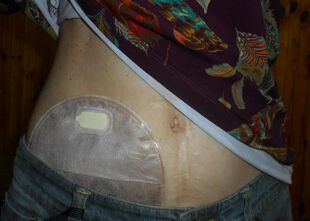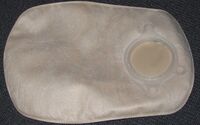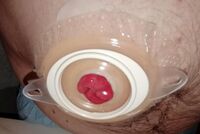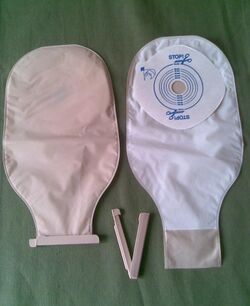Medicine:Ostomy pouching system
| Ostomy pouching system | |
|---|---|
 Ostomy pouching | |
| Specialty | gastroenterology |
An ostomy pouching system[1] is a prosthetic medical device that provides a means for the collection of waste from a surgically diverted biological system (colon, ileum, bladder) and the creation of a stoma. Pouching systems are most commonly associated with colostomies, ileostomies, and urostomies.[2]
Pouching systems usually consist of a collection pouch plastic bag,[3] known as a one-piece system or, in some instances involves a mounting plate, commonly called a flange, wafer or a baseplate, and a collection pouch that is attached mechanically or with an adhesive in an airtight seal, known as a two-piece system. The selection of systems varies greatly between individuals and is often based on personal preference and lifestyle. Ostomy pouching systems collect waste that is output from a stoma. The pouching system allows the stoma to drain into a sealed collection pouch, while protecting the surrounding skin from contamination.[4]
Ostomy pouching systems are air- and water-tight and allow the wearer to lead an active lifestyle that can include all forms of sports and recreation.[citation needed]
Ostomy pouching systems are also sometimes referred to as an appliance, where the term appliance refers to a prosthesis, as a mechanical replacement for a biological function.
Wafers/baseplates/flange
Most wafers/baseplates, also called ostomy barriers, are manufactured using pectin or similar organic material and are available in a wide variety of sizes to accommodate a person's particular anatomy.
The internal opening must be the correct size to accommodate the individual's stoma while protecting the skin from contact with waste. The methods for sizing this opening vary depending on the type of wafer/baseplate; some pre-cut sizes are available, some users customize the opening using scissors. Manufacturers have recently introduced moldable wafers than can be shaped by hand without the need for scissors.[2]
Skin adhesion for modern wafers/baseplates/flanges are optimized on all the five parameters required in an adhesive:
- absorption
- tack and adhesion
- flexibility
- erosion resistance
- ease of removal.
In addition, modern wafers/baseplates/flanges with adhesive border can provide additional security that the system stays in place. Using a barrier film spray before applying a new flange will improve adhesion, soothe irritated skin and protect the skin from irritation.
A wafer/baseplate/flange may last between one and many days before it needs to be replaced; this is highly dependent on the individual's lifestyle, ostomy type, and anatomy.
Pouches

The method of attachment to the wafer varies between manufactures and includes permanent (one-piece), press-on/click ("Tupperware" type), turning locking rings and "sticky" adhesive mounts. The two-piece arrangement allows pouches to be exchanged without removing the wafer; for example, some people prefer to temporarily switch to a "mini-pouch" for swimming, intimate and other short-term activities. Mini-pouches are suitable for minimum usage only.
Pouches can be divided into two basic types: open-end (drainable) and closed-end (disposable).
- Open-end pouches have a resealable end that can be opened to drain the contents of the pouch into a toilet. The end is sealed with either a Velcro-type closure or a simple clip.
- Closed-end pouches can be removed and replaced with a new pouch once the bag is full or the pouch can be emptied and rinsed. The flange or wafer does not need to be replaced.
The use of open-end vs. closed-end pouches is dependent on the frequency in which an individual needs to empty the contents, as well as economics.[4]
Gas is created during digestion, and an airtight pouch will collect this and inflate. To prevent this some pouches are available with special charcoal filtered vents that will allow the gas to escape, and prevent ballooning at night. Some odor can be expelled through the charcoal filter especially if sufficient deodorant is not used in the pouch.
Pouch covers are helpful to disguise the plastic pouch when it is exposed when reaching or other physical activity. These are usually made of cloth and can be decorative or plain to blend in with clothing. Various sources stock sizes for most manufacturers pouches. There are flexible elastic pouch belts available for extreme physical activity but some of these require the pouch to be worn sideways so it does not fill properly and the tight fit causes pancaking of the effluent.
See also
- Colostomy
- Ileostomy
- Urostomy
- Elise Sørensen
References
- ↑ Stedman's Medical Dictionary, Houghton Mifflin Company, 2002, http://dictionary.reference.com/browse/colostomy+bag, "colostomy bag n. A receptacle worn over the stoma to collect feces following a colostomy."
- ↑ 2.0 2.1 "Ostomy Information". United Ostomy Associations of America. http://www.ostomy.org/ostomy_info/whatis.shtml. Retrieved September 3, 2010.
- ↑ "Ostomy". Mayo Clinic. http://www.mayoclinic.com/health/ostomy/SA00072.
- ↑ 4.0 4.1 Lueder, Wendy. "Ostomates' Choices". Broward Ostomy Association. Archived from the original on 2008-11-21. https://web.archive.org/web/20081121081858/http://www.browardostomy.org/newsletter-articles/ostomate-choices.html. Retrieved September 3, 2010.
External links
- United Ostomy Associations of America
- International ostomy association
- European ostomy association
- Coloplast educational material
- Animated instruction guides
- Hollister Ostomy Educational Theatre
- Ostomy Wound Management



